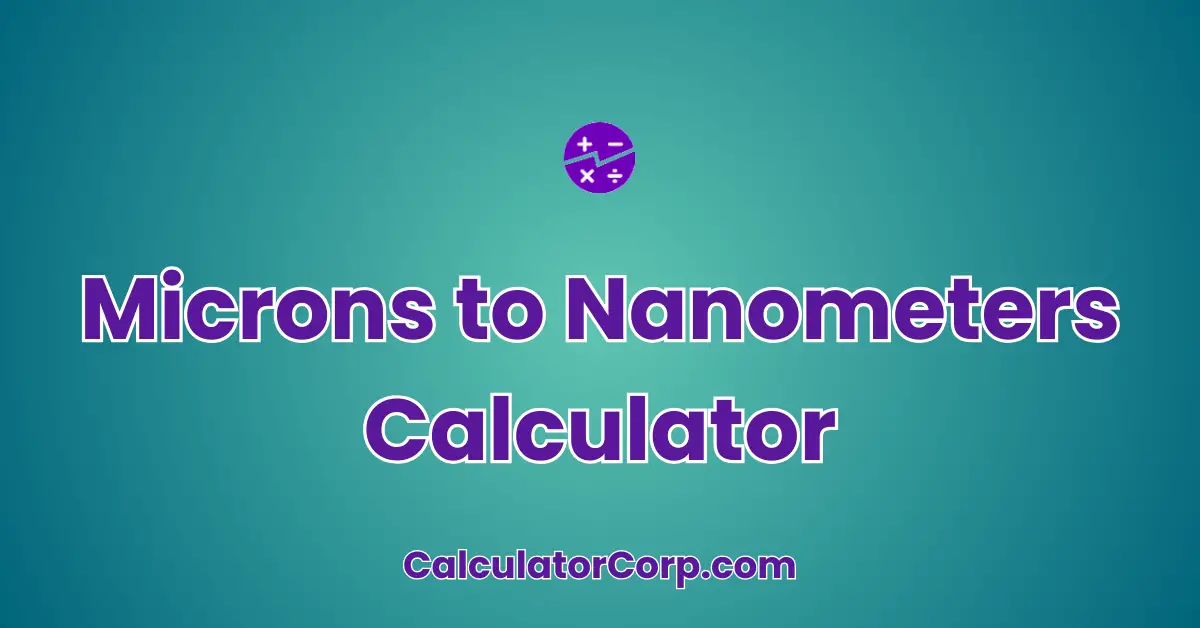The Microns to Nanometers Calculator is a specialized tool designed to convert measurements from microns to nanometers. Its primary purpose is to assist individuals and professionals who require precise conversions in scientific, industrial, or technological applications. If you’re a researcher, engineer, or student, this calculator can facilitate your work by providing quick and accurate results without the need for manual calculations.
Microns to Nanometers Calculator
Select a value from the dropdown or enter your own value to see the conversion to nanometers. (1 Micron = 1,000 Nanometers)
How to Use Microns to Nanometers Calculator?
To use the Microns to Nanometers Calculator, follow these steps:
- Field Explanation: Enter the value in microns that you wish to convert into the input field. Ensure the value is numeric to avoid errors.
- Result Interpretation: After clicking ‘Calculate’, the result displayed will show the equivalent nanometers, formatted with a thousands separator for readability.
- Tips: Double-check your input for accuracy, avoid non-numeric values, and consider the impact of rounding when interpreting results.
Backend Formula for the Microns to Nanometers Calculator
The formula used in this calculator is straightforward but crucial for accurate conversions: Nanometers = Microns × 1000.
Step-by-Step Breakdown: Each micron is equal to 1000 nanometers. Therefore, to convert microns to nanometers, simply multiply the number of microns by 1000.
Illustrative Example: If you have 5 microns, the conversion would be: 5 microns × 1000 = 5,000 nanometers.
Common Variations: While the formula is standard, some scientific contexts may require additional conversions based on environmental factors or specific research needs.
Step-by-Step Calculation Guide for the Microns to Nanometers Calculator
Detailed Steps with Examples:
- User-Friendly Breakdown: Understand that 1 micron equals 1,000 nanometers, so multiplying your micron value by 1,000 will give you the nanometer equivalent.
- Example 1: Convert 3 microns to nanometers: 3 microns × 1000 = 3,000 nanometers.
- Example 2: Convert 12.5 microns to nanometers: 12.5 microns × 1000 = 12,500 nanometers.
Common Mistakes to Avoid: Ensure inputs are numeric and correctly formatted. Avoid using units within the input field, as this can lead to errors.
Real-Life Applications and Tips for Microns to Nanometers
Expanded Use Cases:
- Short-Term Applications: Immediate conversions for laboratory measurements or quality control processes in manufacturing.
- Long-Term Applications: Use in research publications or detailed project planning in fields like nanotechnology or materials science.
Example Professions or Scenarios: Engineers, researchers in nanotechnology, quality control specialists in manufacturing, and students in science disciplines.
Practical Tips:
- Data Gathering Tips: Ensure data accuracy by measuring carefully and avoiding assumptions.
- Rounding and Estimations: Consider the impact of rounding on precision, especially in scientific contexts.
Microns to Nanometers Case Study Example
Expanded Fictional Scenario: Meet Dr. Jane, a nanotechnology researcher who needs to convert measurement data for her latest project. Before ordering supplies, she uses the calculator to ensure that her micron measurements align with supplier specifications in nanometers.
Multiple Decision Points: Dr. Jane uses the calculator first to verify measurements before ordering, and again after a supplier changes a specification, ensuring precision in her materials.
Result Interpretation and Outcome: The calculator helps Dr. Jane avoid costly mistakes, ensuring her research remains on track. By converting her measurements from microns to nanometers, she aligns her findings with industry standards.
Alternative Scenarios: Consider a manufacturing engineer who uses the calculator to adjust machine settings, ensuring that components meet precise specifications.
Pros and Cons of Microns to Nanometers
Detailed Advantages and Disadvantages:
- Pros:
- Time Efficiency: Quickly converts measurements, saving time compared to manual calculations.
- Enhanced Planning: Provides accurate data for informed decision-making in research and manufacturing.
- Cons:
- Over-Reliance: Depending solely on calculator results without understanding the process can lead to errors.
- Estimation Errors: Input errors can lead to inaccurate results, highlighting the need for careful data entry.
Mitigating Drawbacks: Cross-reference results with additional tools and validate assumptions through manual calculations when necessary.
Example Calculations Table
| Microns | Nanometers |
|---|---|
| 1 | 1,000 |
| 10 | 10,000 |
| 100 | 100,000 |
| 250 | 250,000 |
| 500 | 500,000 |
Table Interpretation: This table highlights how an increase in microns directly affects the nanometers, with a simple multiplication by 1,000. The pattern shows a linear relationship, making predictions straightforward.
General Insights: For accurate results, ensure the micron input falls within the optimal range for your specific application.
Glossary of Terms Related to Microns to Nanometers
- Micron:
- A unit of length equal to one-millionth of a meter. Commonly used in the measurement of wavelengths of infrared radiation.
- Nanometer:
- A unit of length equal to one-billionth of a meter, often used in nanotechnology and materials science.
- Conversion Factor:
- The factor used to convert one unit of measure to another. For microns to nanometers, the conversion factor is 1,000.
Frequently Asked Questions (FAQs) about the Microns to Nanometers
1. Why should I use a Microns to Nanometers Calculator?
Using a calculator ensures quick and accurate conversions, saving you time and reducing the risk of errors in manual calculations.
2. Can this calculator be used for scientific research?
Absolutely! The precision of the calculator makes it ideal for scientific research, especially in fields like nanotechnology.
3. What if my input is not a whole number?
The calculator can handle decimal inputs, ensuring accurate results for fractional micron measurements.
4. How do I ensure my inputs are accurate?
Double-check your measurements, use reliable tools for data collection, and ensure no units are entered in the input field.
5. Can I convert back from nanometers to microns?
Yes, the inverse calculation is also simple: divide the nanometer value by 1,000 to get the equivalent microns.
Further Reading and External Resources
- NIST: SI Units – Length: Comprehensive information on metric units including microns and nanometers.
- Nano.gov: Nanotechnology Definitions: Detailed explanations of nanotechnology and related measurements.
- Engineering Toolbox: Length Conversion: A handy reference for various length conversions, including microns to nanometers.

